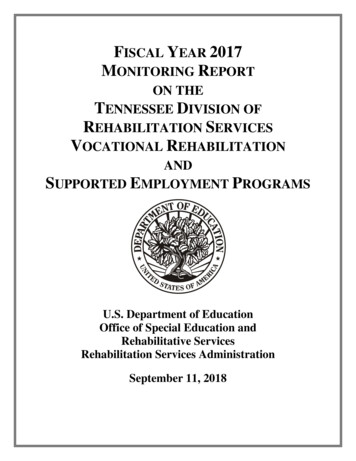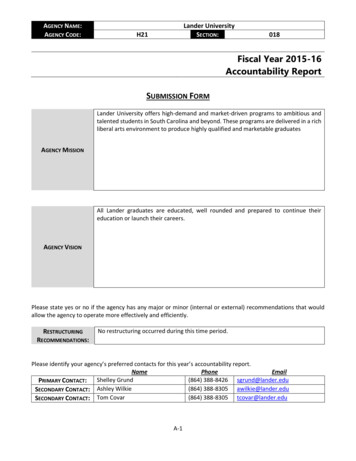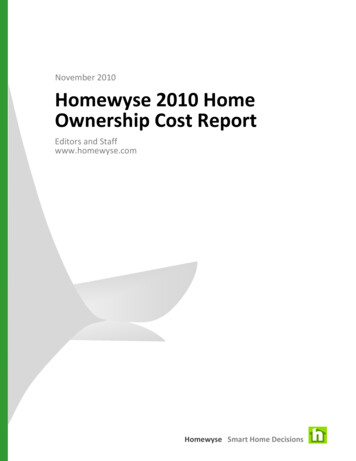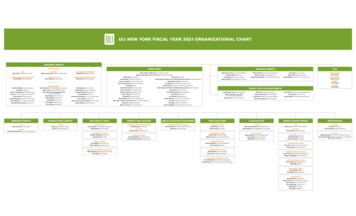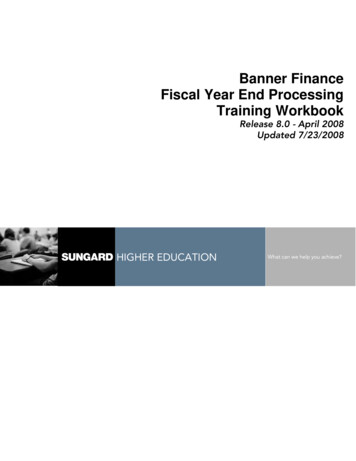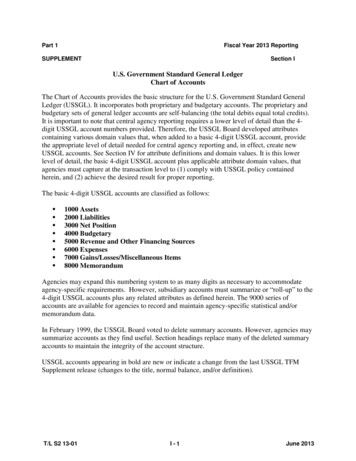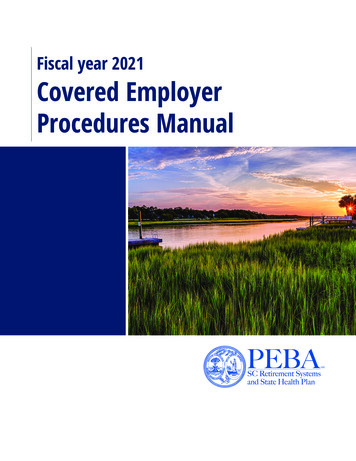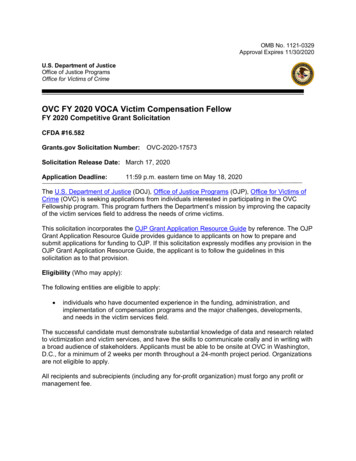
Transcription
FISCAL YEAR 2010MONITORING REPORT ON THEVOCATIONAL REHABILITATION ANDINDEPENDENT LIVING PROGRAMSIN THE STATE OFIDAHOU.S. DEPARTMENT OF EDUCATIONOFFICE OF SPECIAL EDUCATION ANDREHABILITATIVE SERVICESREHABILITATION SERVICES ADMINISTRATIONDECEMBER 17, 2010
TABLE OF CONTENTSPageIntroduction and RSA Review Process .1Part I: Review of Idaho Division of Vocational Rehabilitation (IDVR)Executive Summary .3Chapter 1:Vocational Rehabilitation (VR) and Supported Employment (SE) Programs ofIDVR .6Chapter 2:Fiscal Management of IDVR VR and SE Programs . 19Chapter 3:Progress Toward Redressing Findings From Prior RSA Reviews .35Part II: Review of Idaho Commission for Blind and Visually Impaired (ICBVI)Executive Summary .36Chapter 1:VR and SE Programs of the ICBVI .39Chapter 2:Independent Living Services Program for Older Individuals Who Are Blind (OIB) .51Chapter 3:Fiscal Management of ICBVI VR, SE and OIB Programs . 55Chapter 4:Progress Toward Redressing Findings From Prior RSA Reviews .71Part III: Review of the Idaho Independent Living (IL) ProgramExecutive Summary .72Chapter 1:IL Program .74Chapter 2:Fiscal Management of the IL Program .79Appendix A: IDVR Response .83Appendix B: ICBVI Response .90Appendix C: ID IL Response .98Appendix D: Explanations of Data Tables .100Appendix E: Explanations Applicable to Fiscal Profile Tables .103
INTRODUCTION AND RSA REVIEW PROCESSIntroductionSection 107 of the Rehabilitation Act of 1973, as amended (Act), requires the commissioner ofthe Rehabilitation Services Administration (RSA) to conduct annual reviews and periodic on-sitemonitoring of programs authorized under Title I of the Act to determine whether a state VRagency is complying substantially with the provisions of its State Plan under section 101 of theAct and with the evaluation standards and performance indicators established under section 106.In addition, the commissioner must assess the degree to which VR agencies are complying withthe assurances made in the State Plan Supplement for SE Services under Title VI, Part B, of theAct and the IL programs offered under Title VII of the Act are substantially complying with theirrespective State Plan assurances and program requirements.To fulfill its monitoring responsibilities, RSA: reviews the state agency’s performance in assisting eligible individuals with disabilitiesto achieve high-quality employment and IL outcomes; identifies strengths and challenges related to the agency’s performance, areas ofconsistently high or improved performance and those areas of performance in need ofimprovement; recommends strategies to improve performance; requires corrective actions in response to compliance findings; and provides technical assistance (TA) to the state agency to enable it to enhance itsperformance, meet its goals and fulfill its State Plan assurances.Review ProcessPursuant to the Act, RSA reviewed the performance of the following programs administered byIdaho (ID) IDVR and ICBVI: the VR program, established under Title I; the SE program, established under Title VI, Part B; the IL program authorized under Title VII, Part B; and the OIB, established under Title VII, Chapter 2.In addition, RSA also reviewed the progress of IDVR and ICBVI on: the Corrective Action Plans that were established as a result of findings from RSA’sFiscal Year (FY) 2004 Section 107 monitoring reviews.Information Gathering and Review Process ActivitiesDuring FY 2010, RSA began its review of IDVR and ICBVI by analyzing information from avariety of sources, including but not limited to, RSA’s various data collections, the VR and ILState Plans and the agencies’ State Rehabilitation Council (SRC) Annual Reports. Aftercompleting its internal review, the RSA review team:1
engaged in numerous teleconferences and other information gathering activities withrepresentatives of IDVR and its SRC, ICBVI and its Board, the Statewide IndependentLiving Council (SILC), the Client Assistance Program (CAP), and other stakeholders togain a greater understanding of the agencies’ strengths and challenges related to theadministration and performance of the VR, SE, IL, and OIB programs;conducted an on-site monitoring visit from March 22, 2010 through March 26, 2010,during which it met with representatives of ICBVI, IDVR, the SILC staff, and otherstakeholders, primarily focusing on the operations of the ICBVI; and conducted a secondon-site visit from April 26, 2010 through April 30, 2010, during which it met withrepresentatives of the ID State Board of Education (ISBE), IDVR and its SRC, the ICBVIBoard, the SILC, and other stakeholders, primarily focusing on the operations of IDVR.Through the on-site visits, the review team further gathered and analyzed information andprovided technical assistance in areas already identified by the review team and the agencies.Data Used During the ReviewRSA’s review of IDVR and ICBVI began in the fall of 2009 and ended in the summer of 2010.This report relies primarily on those data collections available for a completed fiscal year prior tothe beginning of the review (i.e., FY 2008) as the sources of data describing the performance ofIDVR and ICBVI. In this report, FY 2008 data is applied to VR and SE while FY 2009 data isapplied to OIB and IL because of its availability during the on-site review.Results of Review ActivitiesAt the conclusion of all monitoring activities, the RSA review team: identified areas of consistently high or improved performance; identified performance areas for improvement and recommended that IDVR and ICBVIundertake specific actions to improve their performance; identified compliance findings and required that IDVR and ICBVI take corrective action;and in collaboration with the agencies, determined whether RSA would provide TA toimprove their performance or correct compliance findings.Review Team ParticipantsMembers of RSA’s ID review team included representatives from each of the five functionalunits within the State Monitoring and Program Improvement Division (SMPID). The teamincluded the following individuals: David Jones and Christyne Cavataio (VR Unit and reviewco-leaders), Charles Sadler (TA Unit), Sue Rankin-White (TA Unit), Craig McManus (FiscalUnit), Deborah Cotter (IL Unit), and Julya Steyh (Data Unit).2
PART I: REVIEW OF IDAHO DIVISION OF VOCATIONALREHABILITATIONEXECUTIVE SUMMARYDuring FY 2010, the RSA reviewed the performance of the following programs authorized bythe Act in the state of ID: the VR program, established under Title I; and the SE program, established under Title VI, Part B;Idaho Administration of the VR and SE ProgramIDVR is the designated state unit (DSU) that administers the VR and SE programs forindividuals with all disabilities except those who are blind and visually-impaired, and is knownas the “general VR agency.” ISBE is the designated state agency for IDVR.Idaho Performance over the Past Five YearsBased on data provided by IDVR through various RSA reporting instruments, the agency’semployment rate increased from 54.59 percent to 65.95 percent during the period beginning inFY 2004 and ending in FY 2008. Over this same period, the number of applicants for VRservices decreased from 6,690 to 6,199, the number of individuals who received services underan individualized plan for employment (IPE) decreased from 3,261 to 3,159, and the number ofindividuals the agency assisted to achieve employment increased from 1,777 to 2,083. From FY2004 through FY 2008, the average hourly earnings of those individuals who achievedemployment outcomes increased from 8.88 to 10.04.Additionally, during the same period, of those individuals who achieved an employmentoutcome, the number who achieved a SE outcome increased from 109 to 117. The averagehourly earnings for these individuals increased from 5.87 to 6.47.Observations of the Agency and StakeholdersThrough the course of the review, agency personnel and representatives of stakeholders, such asthe SRC and the CAP, shared information concerning the administration and performance of theIDVR VR and SE programs.During the review, the agency and its stakeholders made the observations below. In an environment of dwindling resources, IDVR partners with other state and localentities, including local school districts, state corrections and mental health facilities toenhance VR service delivery to individuals with disabilities. Due to decreases in state budgets, schools districts are increasingly relying onperformance results as a benchmark to assess their continued partnership with IDVR.3
IDVR needs to strengthen its collaboration with the two Directors of Special Educationwithin Idaho State Department of Education to provide school districts with currentinformation regarding IDVR services and priorities.IDVR is experiencing an increasing number of staff retirements and challenges with therecruitment of replacements.There is limited funding available to support SE services with the prospect of additionalcuts, creating a waiting list for extended services.Individuals with intellectual disabilities have an increasing need for SE and customizedemployment.Strengths and ChallengesBased on the observations from the agency and its stakeholders and other information gatheredthrough the review process, RSA concluded that IDVR exhibited a variety of strengths andchallenges that impact the performance of its VR and SE programs.StrengthsService Delivery to Special Populations: IDVR has been proactive in providing VR services tospecial populations, including incarcerated individuals, individuals with severe and persistentmental illness (SPMI) and transition-age youths. As part of its interagency agreements, IDVRVR counselors are co-located with mental health facilities, correctional facilities, and schoolsthroughout the state. Strong collaboration is evident by the cross-training of correctional andmental health personnel with IDVR specialty VR counselors.Organizational Structure: IDVR established an organizational structure to maximize theintegration of offices and staff within a geographically large rural state. Each of the three zonemanagers oversees three regions and assumes some of the central office responsibilities,including participating in weekly management meetings. This structure facilitates policydevelopment and communication, resulting in more transparency and support for supervisors andregional staff. On another level, IDVR established a Field Services Executive Council (FSEC)that is comprised of one nominated VR counselor and VR Assistant from each region. TheFSEC provides a voice for the field staff in the agency’s overall operation through the review ofpolicy, performance standards, referral processes, and employee recognition.Technology Utilization to Enhance Communication and Efficiency: IDVR utilizestechnology, such as video-conferencing and a paperless case management system (CMS) toimprove effectiveness and efficiency within the agency. IDVR utilizes a video-conferencingsystem for meetings with regional offices that has improved communication throughout theagency. The system has also been used to facilitate webinar training opportunities among staff.IDVR completed testing of its paperless CMS in early 2010, began regional implementation inspring 2010 with plans for statewide implementation. IDVR’s CMS utilizes signature pads forelectronic signatures at all computers for documents such as applications and IPEs.4
ChallengesHuman Capital: During FY 2008, IDVR’s turnover rate for VR counselors was 17.3 percentwhile the overall turnover rate for all VR staff was 16 percent. Contributing factors included lowwages and staff retirements. As a result of the turnover rate, IDVR has devoted resources totraining new employees and VR counselors and to cultivating new relationships with CommunityRehabilitation Programs (CRPs). In addition, more administrative responsibilities have beenassigned to senior managers. Recruitment of new VR counselors with certified rehabilitationcounselor (CRC) credentials has been challenging as the entry level wage of 37,000 is lower forVR counselors than the wage for VR counselors in the northwest region of the country.Impact of Funding Reductions: IDVR is experiencing a 7.5 percent state reduction in fundingin response to FY 2010 statewide budget cutbacks. As a result of the reduction, IDVR has notbeen able to fill positions or provide salary increases. IDVR is facing a loss of SE extendedservices for state FY 2011 despite a current backlog of 425 individuals. IDVR is also challengedto meet its non-Federal share due to decreases in the budgets of partnering agencies that providematching funds to IDVR, including the ID Department of Corrections (IDOC) and schooldistricts, making it more difficult for IDVR to continue providing services to special populations.Fiscal Planning: IDVR’s fiscal planning activities have focused primarily on monitoring theagency’s annual budget and do not include requisite fiscal forecasting.AcknowledgementRSA wishes to express appreciation to the representatives of IDVR, ISBE, the Governor’s office,the SRC, the SILC, and the stakeholders who assisted the RSA monitoring team in the review ofIDVR.5
CHAPTER 1: VOCATIONAL REHABILITATION AND SUPPORTEDEMPLOYMENT PROGRAMS OF THE IDVRVR and SE Program SystemsThe following sections of this chapter describe the manner in which IDVR administers andoperates the VR and SE programs through a variety of functions or systems, including servicedelivery, personnel, case and data management, quality assurance, and planning.Service DeliveryIDVR is comprised of nine regions and 41 field offices. In FY 2007, IDVR was reorganized toimprove communication between central office management and the field offices. IDVR placedthree tenured regional managers as zone managers and assigned each one to oversee threeregions and provide leadership on some central office responsibilities, including participation inweekly management meetings. The reorganization also established two regions focused onspecialized populations, including incarcerated individuals, individuals with SPMI andtransition-age youths.The average caseload size for general VR counselors is approximately 120. In FY 2008, the topthree services provided by IDVR were VR counseling and guidance at 99.3 percent, assessmentservices at 84.8 percent, and transportation services at 42.3 percent. Through interagencyagreements, partner agencies provide non-Federal funds that IDVR uses to match Federal Title Ifunds for the VR program in the amount of 617,000, representing 16 percent of IDVR’srequired match for its FY 2009 VR basic support grant.IDVR has an agreement with the ID Department of Health and Welfare, Division of BehavioralHealth, Adult Mental Health (HWBH) to provide VR services to eligible individuals with SPMI.There are seven designated mental health VR counselors co-located with regional mental healthagencies or facilities who work in collaboration with mental health courts throughout the state.In FY 2008, individuals with SPMI accounted for 44.8 percent of the total individuals served,compared to 25.1 percent for its peers 1 , and 34.3 percent for general VR agencies nationally.Service delivery to this population has increased by 13.5 percent since FY 2004.IDVR has agreements with three separate divisions within IDOC that work with both juvenilesand adults re-entering the community. These agreements were established in response to thenumber of incarcerated individuals referred to IDVR. IDVR’s presence in this area ispredominantly based in the Treasure Valley region, a suburb of Boise. IDVR has limitedrepresentation in Pocatello. In total, there are six VR counselors co-located within IDOC whomeet with individuals 90 days prior to their release to determine eligibility. The leadingdisabling conditions for those leaving prison are substance abuse and mental health issues.1IDVR’s peer group that receives approximately the same amount of Federal Title I funds or close in regionalproximity consists of general VR agencies in Maine, Nebraska, New Mexico, and Oregon (regional proximity).6
IDVR has agreements with 11 school districts in both rural and urban areas throughout the stateto provide comprehensive VR services to youths with disabilities to prepare them for transitionto-work or post-secondary training. Ten of the 12 IDVR School-to-Work (STW) VR counselorsare co-located in schools. In addition, IDVR established an agreement with ID EducationalServices for the Deaf and the Blind (IESDB) to provide services to consumers served by bothagencies. IDVR begins service delivery with transition-age youths at 16 years of age. In FY2008, the transition population at application represented the largest group of individuals at 35.9percent. In FY 2008, transition-age youths with SPMI accounted for 36.5 percent of the totalindividuals served, compared to 18.8 percent for its peers, and 25.2 percent for general VRagencies nationally.IDVR also established partnerships with 34 CRPs and 26 IdahoWorks (one-stop career centers)throughout the state. Of the 34 CRPs, 12 are non-profit organizations that include shelteredemployment while the remaining 22 are for-profit organizations, providing only SE. Themajority of the CRPs are paid under fee-for-service arrangements, while three CRPs receivemilestone payments. IDVR VR counselors have an itinerant presence in the majority ofIdahoWorks locations except for two offices where they are co-located. Disability programnavigators (DPN) from ID Department of Labor (IDOL) regional offices collaborate with IDVRand participate in IDVR’s annual in-service training. Because there are no regional workforceboards, the DSA represents IDVR on the statewide ID Workforce Development Council (WDC).During FY 2008, 5.6 percent of individuals achieving successful employment outcomes wereindividuals in SE. This percentage is lower than the average of 10.9 percent for combinedagencies nationally and lowest among peers at 9.7 percent. The state-funded ExtendedEmployment Services (EES) program funds CRPs to provide either extended services orsheltered employment. One IDVR contract employee administers the program statewide. Theaverage annual cost per individual is approximately 4,000.Since FY 2004, the state population increased by 9.4 percent. The Hispanic and AmericanIndian populations comprise the two l
fiscal year 2010 monitoring report on the vocational rehabilitation and independent living programs in the state of idaho. u.s. department of education. office of special education and rehabilitative services. reha
